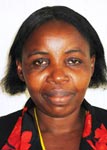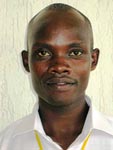Breeders in formation
Nurturing a new generation of African cassava breeders
Download E-publication
|
For the African cassava breeders Community of Practice (CoP) supported by the CGIAR Generation Challenge Programme (GCP), capacity development is important. “Capacity building is critical for the CoP, especially to use the products coming from GCP,” says Emmanuel Okogbenin, the CoP Coordinator. He adds, “The common adage that people are the most important asset is not quite true. The right people are your most important asset. People with the appropriate knowledge, skills and attitudes.” The cassava CoP walks this talk. Meet the postgraduate students funded by GCP working on cassava in Africa in the four CoP target countries (Ghana, Nigeria, Tanzania and Uganda). |
Ghana
 Bright Boakye Peprah, 28
Bright Boakye Peprah, 28
Back to basics to get it right
• Crops Research Institute, Ghana
• MSc student: genotype-by-environment effects on improved varieties, Department of Crop Science, University of Ghana
• Enrolled in 2008, through the CoP
“If I graduate this year, I hope to contribute to the release of a variety to farmers within three to four years. One size does not fit all. In the forest zone, farmers are interested in poundability, while the coastal savannah farmers favour gari, and the forest transition zone farmers are interested in commercial production.”
 Ruth Prempeh, 33
Ruth Prempeh, 33
Saving the harvest
• Crops Research Institute, Ghana
• PhD student: cassava breeding to delay postharvest physiological deterioration (PPD), WACCI, University of Ghana
• Enrolled in 2009, through the GCP–WACCI programme
“Preservation is core. Even if you have all the other good traits but the crop cannot be preserved, then all is lost. There could be a link between beta-carotene and a longer shelf life for cassava. In all, molecular markers would greatly hasten my study. I’m also assessing farmer-preferred varieties to determine whether they possess delayed PPD.”
 Joseph Adjebeng Danquah, 31
Joseph Adjebeng Danquah, 31
A crying need in the North
• Savannah Agricultural Research Institute, Ghana
• PhD student: breeding cassava for drought tolerance, WACCI, University of
Ghana
• Enrolled in 2010, through the GCP–WACCI programme
“It is important to move away from the all too common notion that cassava is an ‘anywhere, anyhow’ crop. Cassava’s natural capacity to withstand drought also needs a boost to improve yields in drylands. My goal is to work on adapting cassava for drylands in the North where there is a great need, because most of the existing varieties have been developed for the South.”
Nigeria
 Bunmi Olasanmi, 36
Bunmi Olasanmi, 36
Accelerating the time track: further and faster for all
• National Root and Tuber Crops Research Institute (NRCRI), Nigeria
• PhD student working on QTLs for early maturity for cassava, University of Ibadan
Nigeria
• Set to graduate in 2010. Enrolled through the CoP
“Due to limited land resources and a long breeding cycle, the need for cassava with the highest yields per unit time and in unit space is critical. Given that yield is a quantitative trait that is difficult to measure and predict, the development and use of QTLs in breeding for the trait will make improvement for earliness in cassava a faster reality. We have identified major QTLs to be shared with the global cassava breeding community.”
Tanzania
 Bernedetha Kimata, 46
Bernedetha Kimata, 46
Marking up the root cause
• Agricultural Research Institute – Sugarcane Research Institute, Kibaha, Tanzania
• MSc student in plant breeding, Egerton University, Kenya
• Enrolled in 2009, through the CoP
“My aim is to develop CBSD mapping population phenotype progenies, and to validate markers of both the progenies and the parents. If SNP makers were available, they would be my preference.”
Uganda

Williams Esuma, 27
What’s in a colour? Plenty!
• National Crop Resources Research Institute (NaCRRI)
• MSc student in crop science, focusing on genetic diversity of yellow-root cassava germplasm in Uganda, Makerere University, Uganda
• Enrolled in 2009, through the CoP
“Beta-carotene is what accounts for the yellow colour in cassava. Once we know the genetic diversity of yellow-root cassava, we will be able to select the right parents to make appropriate crosses. I will use molecular breeding approaches, first at Biosciences Eastern and Central Africa (BecA) for the marker work, then at Makerere for the biochemical analysis of beta-carotene degradation.”
Links
• The cassava community of practice (IBP website)
• A cross-continental coalition on cassava in Africa
• East to West: Country perspectives on cassava in Africa


